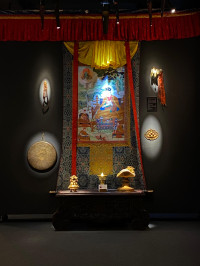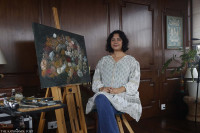Arts
A blend of mythology and modernity
‘Rasa Lila’, showing at The Nepal Art Council, reimagines the Mahabharata through contemporary eyes, challenging conventional norms and exploring the paradoxes of modern morality..jpg&w=900&height=601)
Rishika Dhakal
According to Nietzsche, “Art helps us to know ‘how to make things beautiful, as either creators or enjoyers; as the latter, we can be poets of our lives and give ourselves satisfaction and style, treating our own lives as a creative work and giving it aesthetic value as part of its ethical character. And this requires that we be autonomous individuals, free spirits, rejecting the restrictions that society and conventional morality seek to impose.”
The above paragraph is an extract from AC Grayling’s book ‘The History of Philosophy’. The passage rightly encapsulates the essence of the ongoing exhibition at Nepal Art Council, ‘Rasa Lila: The Divine Dance.’
‘Rasa Lila’ embodies everything unconventional and unique. It doesn't conform to typical norms but instead aligns with the authentic way an individual is likely to perceive things.
The artists behind the exhibition are Priyam Pradhan, Utsab BS Pradhan, Urza Acharya, Binit Maharjan, Julian Shakya, Smarika Phuyal, Shristika Yonzon, and Shubi Lama, who hail from diverse disciplines.
The show is unlike any other exhibition in Kathmandu. For instance, the regular clay sculptures have been replaced by carbon steel sculptures and the use of jenga blocks, and the installed headphones act as a phone booth for the emotions embodied in the statues.
Moreover, the adjustment of light is done so skillfully that it creates the illusion of multiplying the presented figures, adding dynamism to its display.
As I perceived, the theme of the exhibition revolves around fusing the contemporary world with the mythological world of Mahabharata.
Jawaharlal Nehru, in his book ‘The Discovery of India’, mentions that myths provide insights into the thoughts and emotions of people throughout history, reflecting their aspirations, fears, and societal norms.
In a similar vein, with its aim to compare the myths of yesterday with today’s spectacle, the angles used in creating this exhibition represent contemporary perspectives, offering a fresh interpretation of timeless narratives such as Mahabharata itself.
.jpg)
One of the artists, Priyam Pradhan, who is ready to start his academic life abroad, said, “This exhibition marks the celebration of departure and acceptance of the fact that we will have to move away and find our footing in the world.”
Similar to his saying, the exhibition makes the spectators enter the world of Vraja, the highest domain of the heavenly world. Examining the atmosphere of the exhibition, the descriptions of the exhibit labels come to life, providing a sense of calmness and serenity as they begin their observation.
The story of the exhibition begins with Krishna dancing with the Gopis before he leaves to fulfil his duty of freeing his birth parents from the claws of Kamsa, his uncle and the tyrant ruler of Mathura.
While Krishna is fully absorbed in performing ‘Rasa Lila’, Shiva, along with his consort Parvati, arrives to participate in the dance. However, Shiva is restricted from participating. The lack of ‘Sakhibhav’—seeing onset as a companion or friend of the divine—prevents Shiva from joining in the celebration.
As somebody who was educated in an all-girls school, this particular instance transported me back to my school days, making me home-sick of the strong bond that I shared with my girlfriends.
Contrary to my current environment, which lacks that understanding and connection, especially with boys, this feeling of nostalgia gets well articulated in the concept of Sakibhav.
Adamant to participate in the zesty celebration, Shiva turns himself into Gopeshwor Mahadev, a beautiful maiden who can take part in the ‘Rasa Lila’.
With ghungroo tinkling in a feminine foot contrasted with the depiction of masculine dancing hands, the structure cleverly illustrates Gopeshwor Mahadev dancing with the Gopis.
The holy Yamuna river, flowing beside the beautiful Vraja, has symbolic meaning according to the way it is presented in the exhibition. The river is scattered with the jumbled letters of the names of the exhibition's creators, hinting at civilization's ever-flowing nature.
Just like the scattered letters represent the intertwined history, the river has long absorbed the ashes of people from various backgrounds. This makes one realise that nature is not to be owned but to be appreciated and preserved.
.jpg)
The exhibition also represents Draupadi’s vastraharan (disrobing). In the dramatic episode of the Indian Epic, Draupadi, the wife of the Pandavas, is humiliated in the Kaurava court after the Pandavas lose a game of dice to the Kauravas.
As a punishment, the Kaurava prince Dushasana tries to disrobe Draupadi, but Lord Krishna provides her with an endless supply of cloth, preventing her from being stripped.
However, while Draupadi suffers indignity, her family members remain tight-lipped and do nothing on their part to save her from the plight she is facing.
A white saree symbolises Draupadi’s ordeal, and the ending of her saree after being saved by Lord Krishna is depicted in blue. A red light on the head of the statue represents Draupadi's anger towards her family members. Similarly, to help spectators truly connect with Draupadi's plight, a song by artist Smarika Phuyal has been installed in the exhibition, which spectators can listen to from headphones.
Rather than concentrating on the well-known discourse of Draupadi’s plight as a ‘Damsel in Distress’, the exhibition highlights a new perspective. It calls out the paradoxical nature of today's people, who claim to uphold morals and ethics while frequently acting against these principles.
Likewise, blending contemporary fashion with classical mythology, the exhibition offers a fresh representation of the Pandavas. The innovative approach of representing the Pandava brothers with t-shirts of different colours is something that one rarely comes across in an exhibition.
The exhibition has also made a substantial effort to showcase the predicament of modern-day Draupadi through a documentary presentation.
Film-maker Urza Acharya outlines the theme of her film, “One cannot always dwell on happy moments. To enjoy the true embrace of delightful times, one must partake in the adventure of life, which has its challenges and less exciting aspects.”
.jpg)
The five-minute film titled ‘There is no perfection, only life’ revolves around the inner turmoil of the protagonist, who is dressed in a pink dress with tinkling ghungroos.
She often pendulums between two extremes leaving a grey area. The grey area is marked with her being close with herself through the performance of mundane and small tasks.
“By fixing small things, I am confronted with my honest self, the small things end up fixing me too.”
In an era where a person’s identity is often recognised by great achievements attained through complying with the set standards of society, the documentary provides a respite from this routine.
It instead voices the perspective that the pursuit of greatness shouldn’t be one’s core conquest in life. There is a profound wholeness to be discovered in the mundane.
To sum up, from a philosophical perspective, the exhibition can be compared to Neitzche’s pressing question, “How were we to find meaning and purpose in a post-religious world?”
Just like philosopher Heidegger developed a new approach to address Nietzche’s question, the eight artists of this exhibition offer a fresh perspective on interpreting mythologies.
The eight artists in this exhibition do not reject religious traditions; instead, they provide contemporary insights that reinterpret and breathe new life into these narratives.
In this way, the exhibition serves as a modern response to age-old questions, blending classical themes with innovative approaches to offer viewers a deeper understanding of both past and present.
Rasa Lila: The Divine Dance
Where: Nepal Art Council, Babarmahal
Timings: 10:00 am to 5:00 pm
Entry: Free
Till August 3




 5.55°C Kathmandu
5.55°C Kathmandu

%20(1).jpg&w=200&height=120)








